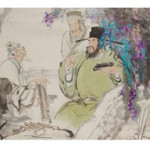At the end of the 12th century, Temujin united all the Mongolian tribes after 10 years of warfare. In 1206, he was chosen their khan, with the title of “Genghis Khan”, which means “mighty monarch”. Under Genghis Khan, the Mongol Empire grew, until it stretched from the northern borders of China to the Danube River in Europe. Under Genghis Khan’s son and successor, the Mongols wiped out the Western Xia kingdom and the Jin Dynasty, and incorporated northern China into their empire.
In 1260, Kublai, the grandson of Genghis Khan, succeeded to the position of khan, and decided on Dadu (today’s Beijing) as his capital. In 1271, Kublai Khan formally proclaimed himself emperor, historically known as Emperor Shizu, of the newly established Yuan Dynasty (1271-1368 AD). After consolidating his hold emperor, historically known as over the north, he moved against the Southern Song Dynasty, which fell in 1279, and China was united once more.
Kublai Khan reformed the system of administration, with Zhongshusheng (Metropolitan Secretariat) in the central government as the highest administrative institution, and Xingzhongshusheng (Branch Secretariat) in local governments as the highest local administrative institutions (called Xingsheng for short). There were 10 Xingsheng altogether in the whole country. Tubo (today’s Tibet) officially became one of China’s administrative regions in the Yuan Dynasty, under the direct administration of Xuanzhengyuan (Commission for Buddhist and Tibetan Affairs) in the central government. In the Yuan Dynasty, too, the island of Taiwan became part of the administrative region of Penghu. This was the beginning of the Chinese central government’s administration over Taiwan.
The setting up of the Xingsheng system strengthened the relations between the central and local governments, as well as those between different local governments. It made the central government’s administration over border areas more effective than that of any previous dynasty, solidifying the unity of China as a multi-ethnic country. Moreover, it was the basis of the administrative systems of later dynasties, and even of today’s China.










发布产品咨询